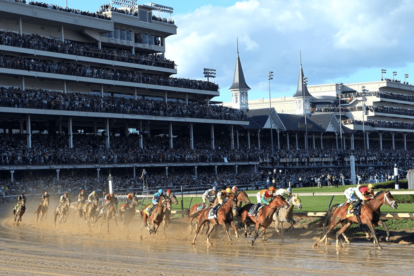As we travel down the Kentucky Derby trail, the best 3-year-old horses are clicking off points in order to run under the twin spires at Churchill Downs on the first Saturday in May.
The points standings early on are somewhat meaningless, but as we turn into the Championship Series and its 100-point races, we examine the standings through a microscopic lens. A single point can sometimes be the difference between getting a chance to Run for the Roses or having to wait for other Triple Crown opportunities.
The Kentucky Derby points system was first implemented in 2013. For three decades prior to that, the Kentucky Derby field was determined by graded stakes earnings.
Still in its infancy, the points system and its intricacies continue to be discerned. Along with having undergone changes since being created, it’s become complicated to determine exactly how many points are needed in order to guarantee a spot because a horse that might qualify on points ultimately doesn’t race, whether due to injury, illness, or other factors. These defections will be discussed later in this article.
In this two-part series, we’ll first examine trends from the first five years of the points system in order to mathematically assess how many points were needed. Later, we’ll analyze the current 2018 points standings and use our Derby Trail Tracker to assess where this year’s horses will need to finish in their final Derby prep races in order to qualify.
Let’s start by putting some meaning to the Derby points.
2013 to 2017 Derby Points Raw Data
The raw data of how many points it takes to make the Derby gate doesn’t tell the full story, but let’s first assess the numbers, then qualify this statistically-valid sample from the past five years.
These were the Derby points needed by the last four horses to qualify in each of the past five years:


The raw data tells us:
1. The lowest point total to qualify for the Derby was 10, by Giant Finish in 2013 (the first year of the Derby points era)
2. The highest point total to qualify was 32, by Mo Tom in 2016
3. In each of the past two years, the bottom four-qualifiers needed between 30 and 40 points, while in the first three years of the points system, the bottom four qualifiers only needed between 10 and 30 points
It should be noted that connections can enter their horse in the Derby with zero points and make the Also Eligible list – if four horses with points don’t enter as Also Eligibles, too. This happened in 2015, when trainer Dallas Stewart entered Tale of Verve as an Also Eligible, though he didn’t draw into the starting gate. It also should be noted that graded stakes earnings serve as the tie-breaker if horses have earned the same amount of points.
2013 to 2017 Derby Points Trends
Before jumping into evaluating how the points have trended, let’s first answer the question, “Why is this analysis important?”
Using the horses above, the first thing that jumps out is the success of the bottom four qualifiers. Of the 10 horses listed above as bottom two qualifiers, three finished second in the Kentucky Derby (Golden Soul in 2013, Commanding Curve in 2014, and Lookin At Lee in 2017). That’s three runner-up finishes in five years from the bottom two of all qualified runners! What’s eerily similar is that all three used closing tactics to get second. Additionally, Battle of Midway finished a valiant third last year as a bottom four qualifier.
Another major trend: second-place finishers from the 100-point prep races that hadn’t previously earned any points have affected the amount of points needed to move past the qualifying bubble. Over the past two years, five horses that received 40 points for finishing second in a 100-point race made the Derby gate as one of the bottom four qualifiers. These include Battle of Midway and Patch last year, and Trojan Nation, Majesto, and My Man Sam in 2016.
Overall, the amount of points needed to make the Derby gate is trending upwards. The chart below graphs the points needed by both the last and the fourth-to-last qualifiers, providing us with the gamut required by bottom four qualifiers (the dashed lines are linear regressions using historical data to project for 2018 and beyond):

Based on a raw data linear regression, it’s projected that the last Derby qualifier will need approximately 38 points this year, while the fourth-to last qualifier will need approximately 44.
The raw data doesn’t tell the full story, though. As mentioned earlier, defections from the race have affected how many points it takes for the bottom qualifiers to make the Derby gate. Notable horses to scratch from the Derby after earning enough points include Hoppertunity, International Star, Stanford, and El Kabeir.
Additionally, owners with multiple entries may decide to run only one horse. Last year, it happened twice. Klaravich Stables decided to only run Practical Joke, even though Cloud Computing also had enough points, while St. Elias Stables decided to start Always Dreaming in the Kentucky Derby and bench Battalion Runner. It worked out for both owners, as Always Dreaming won the Derby and Cloud Computing won the Preakness.
Another cause for defection is that the trainer and/or owner thinks that the horse isn’t ready for the 1 1/4 miles in the Derby, or that the horse isn’t training well enough to run. This was the case last year when trainer Todd Pletcher and owner Sumaya U.S. decided to bypass the Derby with Malagacy, despite the colt earning 50 points for winning the Grade 2 Rebel Stakes.
Even with all of these defections (last year in particular), the points that are needed to make the Derby are trending upwards. An underlying reason why the points keep climbing is that trainers and owners have learned how to click off points with their best horses, compared to the first three years of the system. It’s highly doubtful that a horse will make the Derby gate with 10 points, like Giant Finish did in the first year of the new system in 2013, just as it’s unlikely to see horses with 20 points like Commanding Curve, Harry’s Holiday, and Vinceremos make the gate like they did in 2014. Even in 2015, Frammento and his 20 points only squeezed into the gate after defections. Trainers are targeting points races like they’re golden and tightening the screws to get the most of those coveted points.

Changes Affecting Derby Points Trends
Looking at raw numbers and trends is not a true “apples to apples” comparison, though, because there have been some significant changes over the past six years of the Derby points era that affect the numbers above. In the first five years of the Derby points system, here are the most significant changes:
1. Since the 2015 Breeders’ Cup Juvenile, the points awarded to the winner were doubled for that race, from 10 to 20. Overall, the race now awards 20-8-4-2 points to the top four finishers. This may be one reason why the qualifying points have increased in 2016 and 2017.
2. In 2017, the Grade 3 Sam F. Davis was added back in as a Derby points race, awarding 10-4-2-1 to the top four finishers and adding more points to the total pool in 2016 and 2017. The Grade 3 Grey Stakes (on the synthetic surface at Woodbine) was removed after 2016, but it wasn’t producing Derby starters, so there was a net gain to the points pool.
3. Last year, a separate Japan Road to the Kentucky Derby was added, awarding one spot to a horse from Japan, but that spot wasn’t utilized for the 2017 Derby. If a horse from Japan runs in the Derby this year, then the “floor” on the qualifying points will be raised.
Changes were also implemented this year that will affect how many points it’ll take to make the Derby gate:
1. A separate European Road to the Kentucky Derby was added, awarding one spot in the Derby gate to a horse competing in Europe. If a horse from this series runs in the Derby this year, then the “floor” on the qualifying points for United States runners will be raised.
2. The Grade 3 Lexington Stakes, to be run at Keeneland on April 14, had its points value increased and will now offer 20 points to the winner (20-8-4-2 points to the top four compared to 10-4-2-1 in previous years). Connections may target this race to get points in an easier fashion than competing in the Grade 1 Arkansas Derby on the same day.
3. The Grade 3 Jeff Ruby Steaks (formerly the Spiral Stakes) was won by Blended Citizen at Turfway on Saturday. This race had its points reduced, though, with the winner receiving only 20 points, as opposed to the 50 that were awarded in prior years. Overall, the points were reduced from 50-20-10-5 to 20-8-4-2 for the top four. This reduction should help stabilize the floor to qualify for the Derby. Over the first five years of the Derby points systems, winners of this race earning 50 points to run in the Derby included Fast and Accurate (2017), Oscar Nominated (2016), and We Miss Artie (2014). Black Onyx won this race and was scratched from the 2013 Derby, while the 2015 winner, Dubai Sky, suffered a hind leg injury while training for the Derby and never made the gate.
4. The $400,000 Springboard Mile at Remington, run on December 17 last year, was added to the Derby points races, but it coincidentally replaced the Grade 2 Delta Jackpot, which wasn’t held. We’ll see next season if both races award points.

Conclusion
After all of the number-crunching, it can be forecast that a horse needs to earn approximately 34 to 38 points to safely become the last qualifier in the gate for the 2018 Derby. Still, this number could rise to 40 points or above quickly, based on the three major unknowns below:
1. How many defections will occur in the next six weeks leading up to the first Saturday in May?
2. Will horses entered from the Japan and/or European Roads to the Kentucky Derby take one or two spots from the gate, thus raising the points floor for the United States horses?
3. Of the slew of horses that haven’t previously earned any points on the Derby trail, how many will score 40 points for finishing second, or 100 points for winning, in the last round of Derby preps?
We’ll delve a bit deeper into item three in the continuing installment of our points analysis next week. In the meantime, check out the Derby Trail Tracker for constant updates to all probables for the upcoming Derby preps and follow me on Twitter @SaratogaSlim for additional updates.












